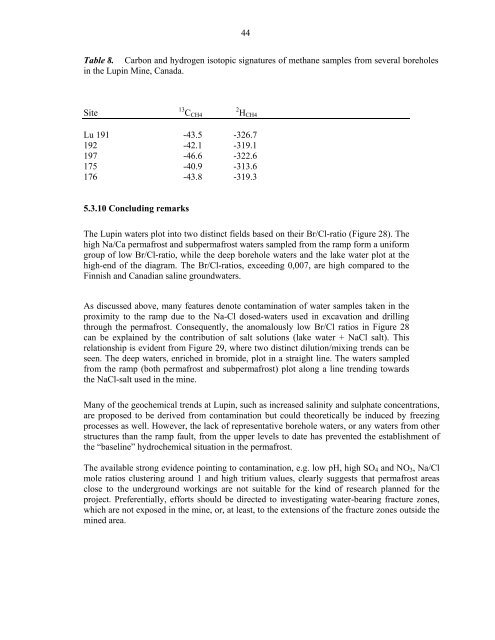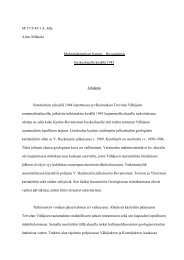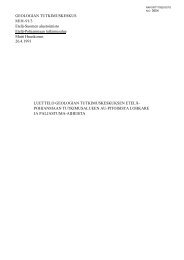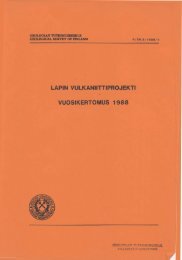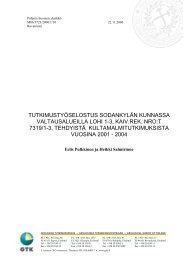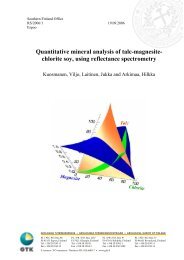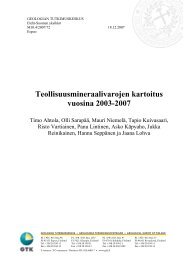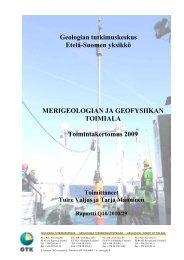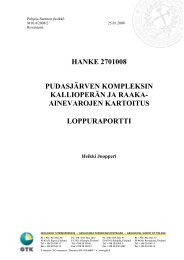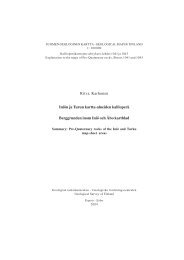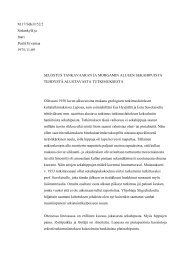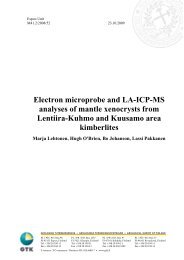REPORT OF PHASE
REPORT OF PHASE
REPORT OF PHASE
- No tags were found...
Create successful ePaper yourself
Turn your PDF publications into a flip-book with our unique Google optimized e-Paper software.
44Table 8. Carbon and hydrogen isotopic signatures of methane samples from several boreholesin the Lupin Mine, Canada.Site13 C CH42 H CH4Lu 191 -43.5 -326.7192 -42.1 -319.1197 -46.6 -322.6175 -40.9 -313.6176 -43.8 -319.35.3.10 Concluding remarksThe Lupin waters plot into two distinct fields based on their Br/Cl-ratio (Figure 28). Thehigh Na/Ca permafrost and subpermafrost waters sampled from the ramp form a uniformgroup of low Br/Cl-ratio, while the deep borehole waters and the lake water plot at thehigh-end of the diagram. The Br/Cl-ratios, exceeding 0,007, are high compared to theFinnish and Canadian saline groundwaters.As discussed above, many features denote contamination of water samples taken in theproximity to the ramp due to the Na-Cl dosed-waters used in excavation and drillingthrough the permafrost. Consequently, the anomalously low Br/Cl ratios in Figure 28can be explained by the contribution of salt solutions (lake water + NaCl salt). Thisrelationship is evident from Figure 29, where two distinct dilution/mixing trends can beseen. The deep waters, enriched in bromide, plot in a straight line. The waters sampledfrom the ramp (both permafrost and subpermafrost) plot along a line trending towardsthe NaCl-salt used in the mine.Many of the geochemical trends at Lupin, such as increased salinity and sulphate concentrations,are proposed to be derived from contamination but could theoretically be induced by freezingprocesses as well. However, the lack of representative borehole waters, or any waters from otherstructures than the ramp fault, from the upper levels to date has prevented the establishment ofthe “baseline” hydrochemical situation in the permafrost.The available strong evidence pointing to contamination, e.g. low pH, high SO 4 and NO 3 , Na/Clmole ratios clustering around 1 and high tritium values, clearly suggests that permafrost areasclose to the underground workings are not suitable for the kind of research planned for theproject. Preferentially, efforts should be directed to investigating water-bearing fracture zones,which are not exposed in the mine, or, at least, to the extensions of the fracture zones outside themined area.


